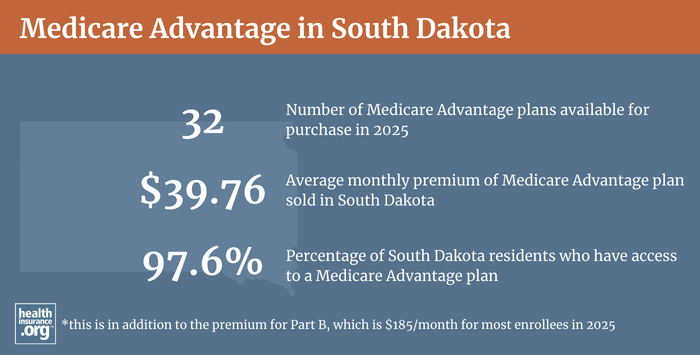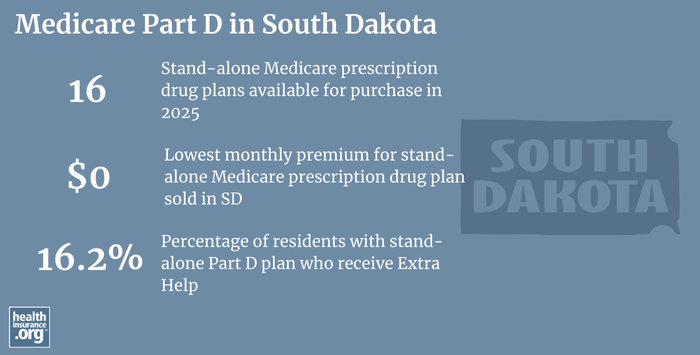
Medicare in South Dakota
Original Medicare, Medicare Advantage, Part D prescription drug, and Medigap coverage in South Dakota
Key takeaways
- More than 198,000 residents are enrolled in Medicare in South Dakota.1
- South Dakota’s Medicare Advantage enrollment is lower than the national average, with only 71,000 beneficiaries enrolled in Medicare Advantage plans.1
- South Dakota residents can select from among 16 stand-alone Medicare Part D prescription drug plans for 2025, with premiums that start at $0 per month.2

South Dakota Medicare enrollment
As of September 2024, 198,831 residents were enrolled in Medicare in South Dakota,1 amounting to about 18% of the state’s population.3
Most people become eligible for Medicare enrollment when they turn 65 years old, but Medicare eligibility is also triggered by a disability for which disability benefits are received for more than 24 months, or a diagnosis of end-stage renal disease (ESRA) or amyotrophic lateral sclerosis (ALS). Nationwide, about 11% of all Medicare beneficiaries are under the age of 65,4 but only 8% of South Dakota Medicare beneficiaries are under the age of 65.1
Learn about Medicare plan options in South Dakota by contacting a licensed agent.



Explore our other comprehensive guides to coverage in South Dakota

We’ve created this guide to help you understand the South Dakota health insurance options available to you and your family, and to help you select the coverage that will best fit your needs and budget.
Learn about health insurance coverage options in South Dakota.


Hoping to improve your smile? Dental insurance may be a smart addition to your health coverage. Our guide explores dental coverage options in South Dakota.


Learn about South Dakota’s Medicaid expansion, the state’s Medicaid enrollment and Medicaid eligibility.


Short-term health plans provide temporary health insurance for consumers who may find themselves without comprehensive coverage. Learn more about short-term plan availability in South Dakota.
Learn about short-term insurance regulations in South Dakota.

Frequently asked questions about Medicare in South Dakota
What is Medicare Advantage?
Medicare beneficiaries can choose to receive their benefits directly from the federal government via Original Medicare or enroll in Medicare Advantage plans (as long as Medicare Advantage plans are available in their area, which is the case in over half of South Dakota).5
Original Medicare includes Medicare Part A (hospital coverage) and Medicare Part B (medical/physician coverage). Medicare Advantage includes all of the benefits of Medicare Part A and Part B (albeit with very different out-of-pocket costs), and Medicare Advantage plans typically provide additional benefits, such as integrated and extra benefits like dental and vision. But provider networks may be limited with Medicare Advantage, and out-of-pocket costs (deductible, coinsurance, and copays) are often higher than they would be under Original Medicare plus a Medigap insurance plan. There are pros and cons to either option, and no single solution works for everyone.
As of September 2024, 71,971 Medicare beneficiaries in South Dakota were enrolled in Medicare Advantage plans.1
For 2025 coverage, a total of 32 Medicare Advantage plans are available in South Dakota, although plan options vary from one county to another.2
Medicare Advantage enrollment is available when a person is first eligible for Medicare, and also during Medicare’s annual election period (October 15 to December 7 each year). This annual window gives Medicare beneficiaries the opportunity to switch between Medicare Advantage plans and Original Medicare (and add or drop a Medicare Part D prescription plan). Medicare Advantage enrollees also have the option to switch to a different Advantage plan or to Original Medicare during the Medicare Advantage open enrollment period, which runs from January 1 to March 31.

What is Medigap?
Nearly half of Original Medicare beneficiaries receive supplemental coverage through an employer-sponsored plan or Medicaid.6 But for those who don’t, Medigap plans (also known as Medicare supplement insurance plans) are designed to pay some or all of the out-of-pocket costs (deductibles, copays and coinsurance) that Medicare beneficiaries would otherwise have to pay themselves. Original Medicare does not limit out-of-pocket costs, so most enrollees maintain some form of supplemental coverage; Medigap plans are what’s available for people who don’t have access to an employer-sponsored plan (including retiree plans) or Medicaid.
Although Medigap plans are sold by private insurers, the plans are standardized under federal rules. There are ten different plan designs (differentiated by letters, A through N), and the benefits offered by a particular plan (Plan A, Plan F, etc.) are the same regardless of which insurer is selling the plan. So plan comparisons are much easier for Medigap policies than for other types of health insurance; consumers can base their decision on premiums and less tangible things like customer service, since the benefits themselves are uniform.
40 insurers are licensed to offer Medigap plans in South Dakota.7 According to America’s Health Insurance Plans (AHIP’s) analysis, 73,220 people in the state had Medigap coverage as of 2022.8
Unlike other Medicare plan enrollment (Medicare Advantage plans and Medicare Part D prescription drug plans), there is no annual open enrollment window for Medigap plans. Instead, federal rules provide a one-time six-month window when Medigap coverage is guaranteed-issue. This window starts when a person is at least 65 and enrolled in Medicare Part B (you must be enrolled in both Part A and Part B to buy a Medigap plan).
People who aren’t yet 65 can enroll in Medicare if they’re disabled and have been receiving disability benefits for at least two years, or if they have end-stage renal disease (ESRD) or amyotrophic lateral sclerosis (ALS) (11% of Medicare beneficiaries nationwide,4 and about 8% in South Dakota, are under age 651). Federal rules do not guarantee access to Medigap plans for people who are under 65, but the majority of the states have rules to ensure that disabled Medicare beneficiaries have at least some access to Medigap plans.
In South Dakota, Medicare beneficiaries under the age of 65 have the same Medigap Open Enrollment Period as people who are gaining access to Medicare due to age.9 These enrollees have six months from the time they enroll in Medicare Part B to select a guaranteed-issue Medigap plan.
For South Dakota Medigap plans that base rates on the age of the enrollee (which is nearly all of them), the premiums for people under age 65 are equal to the premiums for people who are 75, because state regulations prohibit Medigap insurers from charging enrollees under age 65 more than they charge enrollees who are 75.10
This is a much more restrictive model than many other states use, as it keeps Medigap premium fairly low for people under age 65 (in many states, Medigap premiums for people under 65 are two to four times more expensive for those under 65, versus people who are 65; in South Dakota, the difference in price is less than 35% in most cases).
(Note that the only Medigap carrier in South Dakota that uses community rating — instead of an age-based rating approach — for enrollees 75 and older is AARP/UnitedHealthcare. They do not have to follow the same rating rules that other carriers must use for enrollees under age 65.)
South Dakota has an extensive list of state statutes that apply to rate and form filing requirements for Medigap plans.
People who are enrolled in Medicare prior to age 65 will have another Medigap Open Enrollment Period, when they turn 65, during which they can switch to a different Medigap plan and get the lower premiums that apply to people who are eligible for Medicare due to age, rather than disability.
Although the Affordable Care Act eliminated pre-existing condition exclusions in most of the private health insurance market, those regulations don’t apply to Medigap plans. Medigap insurers can impose a pre-existing condition waiting period of up to six months, if you didn’t have at least six months of continuous coverage prior to your enrollment. And if you apply for a Medigap plan after your initial enrollment window closes (assuming you aren’t eligible for one of the limited guaranteed-issue rights), the insurer can look back at your medical history in determining whether to accept your application, and at what premium.
What is Medicare Part D?
Original Medicare does not cover outpatient prescription drugs. More than half of Original Medicare beneficiaries have supplemental coverage via an employer-sponsored plan (from a current or former employer or spouse’s employer) or Medicaid, and these plans often include prescription drug coverage.6 But Medicare enrollees without prescription drug coverage through Medicaid or an employer-sponsored plan may need to obtain Medicare Part D prescription drug coverage. Part D prescription drug coverage can be purchased as a stand-alone plan, or as part of a Medicare Advantage plan that includes Medicare Part D prescription drug coverage.
For 2025 coverage of prescription drugs in South Dakota, there are 16 stand-alone Medicare Part D prescription drug plans available, with premiums that start as low as $0 per month.2
As of late-2024, there were 112,749 Medicare beneficiaries in South Dakota who had coverage for prescription drugs under stand-alone Medicare Part D prescription drug plans.1 Another 38,656 had Part D prescription coverage as part of their Medicare Advantage Prescription Drug plans (ie, MA-PDs).1 Although the number of South Dakota beneficiaries with MA-PD coverage is growing, it’s still a small segment of overall Part D coverage in the state. Nationwide, there are now more people with MA-PD coverage than with stand-alone Part D coverage, but that’s not the case in South Dakota.
Medicare Part D prescription drug plan enrollment follows the same schedule as Medicare Advantage plans: Beneficiaries can enroll in a Medicare Part D prescription drug plan when they’re first eligible for Medicare, and the Medicare Annual Enrollment Period (October 15 to December 7) provides an opportunity to enroll or change Medicare Advantage, Medicare Supplement or Medicare Part D prescription drug plans, with coverage effective the following January.

What additional resources are available for Medicare beneficiaries and their caregivers in South Dakota?
Got questions about filing for Medicare benefits in South Dakota? You can contact SHIINE, South Dakota’s Senior Health Insurance Information and Insurance Education program, with questions related to Medicare eligibility in South Dakota, Medicare enrollment in South Dakota, or changing various aspects of your Medicare coverage after you’re enrolled.
The South Dakota Department of Social Services has information about Medicare Savings Programs that are available to residents with limited income and assets. And this page provides a thorough overview of how South Dakota’s Medicaid program provides assistance to Medicare beneficiaries with limited financial means.
The South Dakota Divison of Insurance licenses, regulates, and oversees the health insurance companies that offer coverage in the state (for Medicare beneficiaries, Medigap plans are regulated at the state level), as well as the brokers and agents who sell policies. Their office can provide information and address a variety of consumer inquiries and complaints about the entities they regulate.
The Medicare Rights Center is a nationwide service that can provide assistance and information to Medicare beneficiaries and their caregivers who have questions about Medicare eligibility, enrollment, or benefits.
Louise Norris is an individual health insurance broker who has been writing about health insurance and health reform since 2006. She has written dozens of opinions and educational pieces about the Affordable Care Act for healthinsurance.org.

Looking for more information about other options in your state?
Need help navigating health insurance options in South dakota?
Explore more resources for options in SD including ACA coverage, short-term health insurance, dental and Medicaid.
Speak to a sales agent at a licensed insurance agency.
Footnotes
- “Medicare Monthly Enrollment – South Dakota.” Centers for Medicare & Medicaid Services Data. Accessed January, 2025. ⤶ ⤶ ⤶ ⤶ ⤶ ⤶ ⤶ ⤶
- ”Fact Sheet: Medicare Open Enrollment for 2025” (125) Centers for Medicare & Medicaid Services. Sep. 27, 2024 ⤶ ⤶ ⤶
- “U.S. Census Bureau Quick Facts: U.S. & South Dakota.” U.S. Census Bureau, July 1, 2024. ⤶
- “Medicare Monthly Enrollment – US” Centers for Medicare & Medicaid Services Data. Accessed January, 2025. ⤶ ⤶
- ”Medicare Advantage 2025 Spotlight: First Look” KFF.org Nov. 15, 2024 ⤶
- Ochieng, Nancy, Gabrielle Clerveau, and Tricia Neuman. “A Snapshot of Sources of Coverage among Medicare Beneficiaries.” Kaiser Family Foundation, August 14, 2023. ⤶ ⤶
- “Explore your Medicare coverage options.” Medicare.gov. Accessed October, 2024. ⤶
- ”The State of Medicare Supplement Coverage” AHIP. May 2024 ⤶
- “Medicare Supplement Policies.” Department of Labor and Regulation. Accessed October 6, 2023. ⤶
- “Open Enrollment Required for Medicare Eligible Individuals Regardless of Age.” South Dakota Legislature. Accessed October 6, 2023. ⤶

